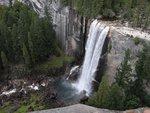What does this mean for me?
- For your safety, do not enter or drink from Tenaya Creek, which flows from above Mirror Lake to where it enters the Merced River near North Pines Campground.
- Filtering and/or boiling the water is not effective against this type of algae.
- Prevent pets from drinking the water and eating or touching algae. In particular, prevent dogs from eating dried algal mats on shore.
- Please report any large algal blooms and/or algae that is particularly bright, bubbly, strange-looking, or appears like a haze in the water.
- Do not disturb algal mats in any way. Wading or swimming can cause toxins to be released into the water.
- If you suspect a site has toxic algae, do not enter the water and do not drink water from the area. While some sites are signed based on testing results, it’s likely that algae exists in other parts of Yosemite Valley. Don’t rely on signage alone.
If you think algae may be in the water:
- Do not enter the water.
- Do not drink the water, even if treated.
- Do not let pets into the water, allow them to drink the water, or eat algae on the shore.
- sore throat or congestion;
- coughing, wheezing, or difficulty breathing;
- red, or itchy skin, or a rash;
- skin blisters or hives;
- earache or irritated eyes;
- diarrhea or vomiting;
- agitation;
- headache; and/or,
- abdominal pain.
Is the park monitoring for harmful algal blooms? The park continues monitoring for toxic algae and testing for toxins throughout the park. You can learn more about harmful algal blooms at https://mywaterquality.ca.gov/habs/.


